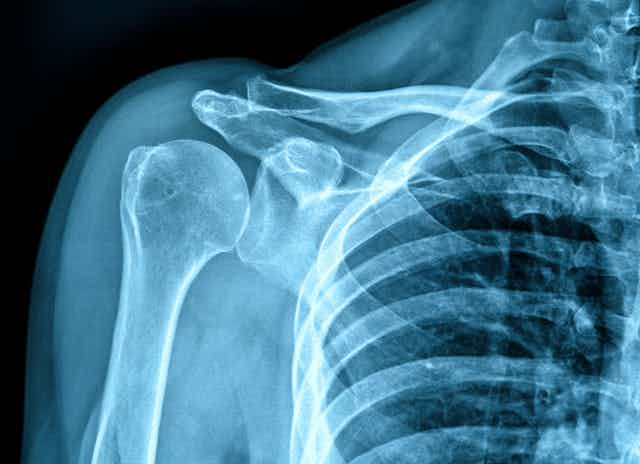In the first week of January, the Home Office announced that it would set up a committee to advise on the use of scientific methods – such as x-rays and MRI imaging – to determine the age of asylum seekers.
Age assessment is part of the asylum application process when it is unclear whether the person seeking asylum is over 18. It’s vital to get this right from various perspectives. Children who are mistakenly aged as adults will be placed in adult housing, endangering them and denying them support they are entitled to. Conversely, when adults are wrongly aged as minors, they may be claiming support they are not entitled to.
Methods like medical imaging techniques may provide better age estimates than the UK’s current system, which is based on an assessment by social workers in situations where the person’s age is in question.
And as a diagnostic radiographer, I am familiar with the methods involving medical imaging. As an osteoarchaeologist, I use dating methods like dental development to assess the age of skeletal remains. While assessing the age of living individuals is a slightly different scientific process, these methods provide more accurate results than the UK’s current system.
Current methods
There are two main reasons why age assessment may be needed in asylum cases. Either the applicant is obviously a child but lacks documentation to prove it. Or the applicant claims to be a minor (without documentation or with documentation that is suspected to be falsified), which is disputed by those handling the case.
Currently, an initial age validity assessment on arrival is conducted by Border Agency staff based on a person’s appearance and demeanour. If their age is disputed, social workers conduct an assessment to determine the applicant’s level of maturity. There are several problems with this process, which has been criticised as too inaccurate, unscientific and biased.
Firstly, these assessments take place without the support of family or anybody known to the potential child. The setting may be unfamiliar and upsetting. Secondly, how someone expresses themselves may not be a good guide to their age, but may be influenced by the experience, past responsibilities (or lack thereof), coping behaviours and past traumas. Children may appear more demure (hence younger) or more resilient (hence older) than their actual age.
Lastly, officials may be assessing the age of children from a variety of foreign countries, with limited understanding of the cultural diversity and responsibilities posed on children, and what it means to grow up in a country of conflict. They may also be using translators for communication.

Scientific alternatives
Most other European countries already use scientific methods to determine the age of asylum seekers. These include analysis of a combination of dental development, skeletal maturity and pubertal changes.
Dental development is done by using a dental x-ray of the person and then comparing the development of the teeth to images of dental development from children of similar age and same sex. This can then provide what is called a “dental age”. Skeletal maturity is assessed using imaging techniques such as x-rays or computer tomography, a combination of several x-ray images of the body part.
Commonly used is a hand and wrist x-ray, which is compared to a series of developmental charts, again from children of known ages and same sex. This method is already used in the UK for clinical purposes as a reliable method for assessing issues such as growth hormone deficiency, or early or delayed puberty.
Some have criticised these methods for exposing children to unnecessary radiation that does not have a medical therapeutic purpose, although MRI imaging can be used instead of methods involving radiation. However, the radiation dose from a dental x-ray or a hand and wrist x-ray is very small. A small dental x-ray will yield the same radiation as we get in a day from our environment.
The last method used in some European countries for child age assessment is pubertal changes. This involves a visual inspection of the sexual maturity of breast development in females or genital development in males and pubic and armpit hair development in both sexes. This method has been criticised for being inappropriate and intrusive as it requires the nudity of the asylum seeker, which may cause psychological distress for a young person in an already vulnerable situation.
For all the scientific methods, there are some disagreements on exactly how accurate these methods are for assessing age. Results have differed depending on which method is tested and who they are tested on. Hopefully, the committee appointed by the Home Office will be able to determine which methods would be most appropriate for those arriving in the UK.
In 2018, the European Asylum Support Office published updated guidelines for member countries. They recommended using the least intrusive and most accurate methods of age assessment, which can vary between cases – for example, you may have better data on dental records for making comparisons with children from a particular age and country or better data for hand and wrist x-rays for others. The guidance also recommends using a combination of methods, and not just an assessment of psychological or developmental maturity.
Establishing an advisory committee for age assessment of asylum seekers in the UK will begin to bring the UK in line with procedures followed by European countries. Incorporating more methods and having the flexibility to choose between methods most applicable to the person being assessed can only be an improvement to current methods.
The committee set up by the Home Office will be led by Professor Dame Sue Black, who I trained under for my degree in forensic anthropology at the University of Dundee. Her experience as a forensic anthropologist is second to none in the UK – her appointment should ensure a confidence in the scientific advice and recommendations deriving from this committee.

